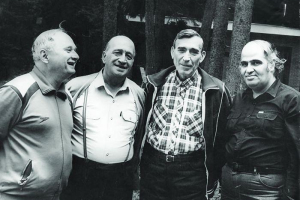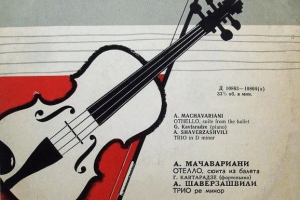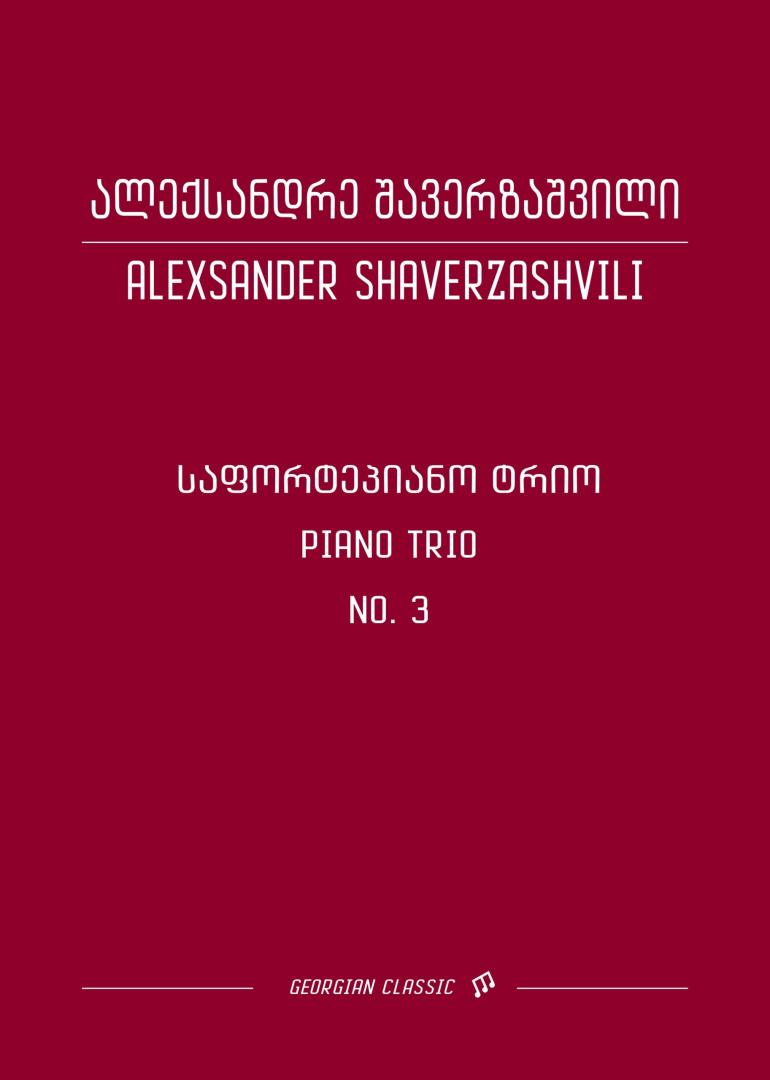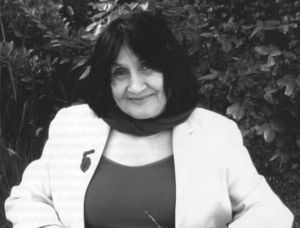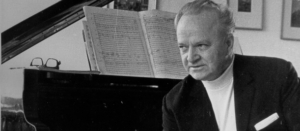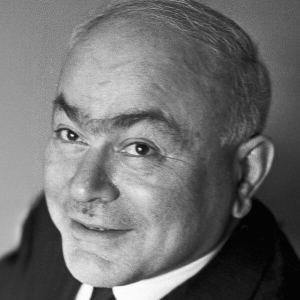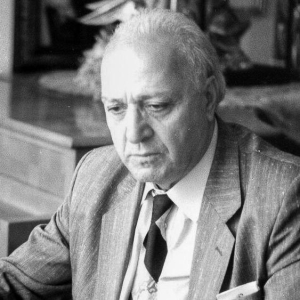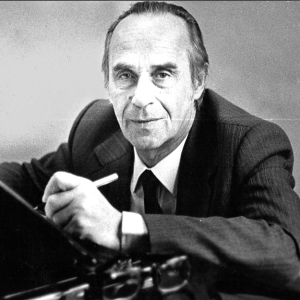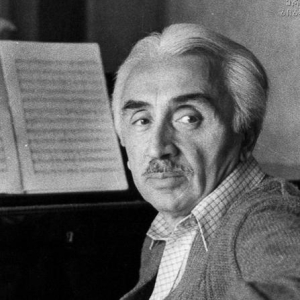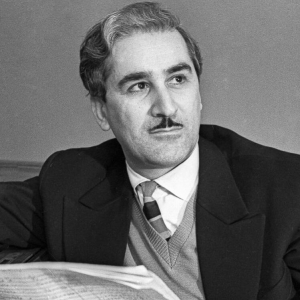Alexsander
Shaverzashvili
Alexsander Shaverzashvili
(1919 – 2003)
Alexsander Shaverzashvili – Georgian Composer, Teacher and Art History Candidate (1951), Honored Worker of Art of Georgia (1961), Honored Worker of Art of Abkhazia (1979), People’s Artist of Georgia.
Date of birth – July 8, 1919
Place of birth – Tbilisi, Georgia
Date of death – May 20, 2003
Place of death – Tbilisi, Georgia
He is buried in Didube Pantheon of Writers and Public Figures – Tbilisi
BIOGRAPHICAL DATA
1943 – Graduated from the Tbilisi State Conservatory named after Vano Sarajishvili, majoring in composition (Andria Balanchivadze’s class);
1947 – Graduated from Vano Sarajishvili Tbilisi State Conservatory;
1946 – 1955 – music editor of “Georgian Film” film studio, composer of film chronicle;
1946 – 1955 – Teacher of Zakaria Paliashvili Musical Gymnasium (Decade of Talents) (composition, orchestra course, theoretical disciplines);
Since 1949 – Teacher at the III Music School named after Meliton Balanchivadze;
1958 – 1959 – Head of the Georgian Philharmonic Chamber Department;
Since 1952 – Tbilisi State Conservatory named after Vano Sarajishvili – teacher – docent (1960), professor (1971); (1968, professor, 1971, vice–rector);
1968 – 1979 – Head of the composition department of Vano Sarajishvili Tbilisi State Conservatory;
1943 – Vice–rector of Tbilisi State Conservatory named after Vano Sarajishvili;
1951 – Candidate of art history – thesis topic – “Symphonic poems “Zviadauri” (Shalva Mshvelidze) and “Gandegili” (Grigol Kiladze) and their role in the development of Georgian symphony”
AWARDS AND RECOGNITION
1946 – Member of the Union of Composers of the Soviet Union
Union of Composers of Georgia, member
1958 – Order of Honor
1961 – Honored Art Worker of Georgia
1979 – Honored Art Worker of the Abkhazian SSR
1982 – People’s Artist of Georgia
1999 – Order of Honor
for his great personal contribution to the development of Georgian musical art, for his fruitful creative, pedagogical and public work
Alexsander Shaverzashvili
(1919 – 2003)
SELECTED WORKS
MUSIC FOR THE THEATER
1944 – “Mzia” – Opera in 3 Acts – (libretto – A. Shaverzashvili)
1954 – “Marine” – Opera in 3 Acts – (libretto – M. Baratashvili)
1964 – “Oedipus the King” – Opera-Oratorio in One Act – (libretto – A. Shaverzashvili)
1966 – “Towards a new shore” – Opera in 4 Acts – (libretto – P. Gruzinski)
1973 – “Fiery Years” – Opera in 2 Acts – (libretto – P. Gruzinski)
1958 – “Maneuvers” – Operetta
1959 – “Parade” – Operetta in 3 Acts – (libretto – C. Geleishvili)
1967 – “Nino” – Operetta in 3 Acts – (libretto – G. Nakhutsrishvili)
1944 – “Elguja” – Ballet in 3 Acts – (libretto – A. Shaverzashvili)
ORCHESTRAL MUSIC
1945 – Symphony N 1
1962 – Symphony N 2
1976 – Symphony N 3 “Chamber” – Dedicated to D. Shostakovich
1987 – Symphony N 4
1994 – Symphony No. 5 – for Chamber Orchestra
1976 – “Celebratory Overture” – for Symphony Orchestra
1944 – “Elguja” – Symphonic Poem
1948 – “Kajeti” – Symphonic Poem – Based on the Poem by Sh. Rustaveli “The Knight in the Panther’s Skin”
1981 – “Small land” – Symphonic Poem
1954 – “Waltz” – Symphonic Picture
1958 – “Mtkvari” – Symphonic Picture
1940 – Concerto for Piano and Symphonic Orchestra
1964 – Concerto for Violin and Symphonic Orchestra
1979 – Concerto for Trombone and Symphonic Orchestra
CHAMBER-INSTRUMENTAL MUSIC
1945 – String Quartet No. 1
1976 – String Quartet N 2
1988 – String Quartet N 3
1967 – “Fantasia on Czech Themes” – for String Quartet
1971 – Suite for String Quartet
1973 – “Miniatures” – for String Quartet – “Fugetta”, “Sad Song”, “Dance-Scherzo”
1952 – Piano Trio N 1
1968 – Piano Trio N 2
1979 – Piano Trio N 3
1983 – Piano Trio N 4
1986 – Piano Trio N 5
1987 – Piano Trio N 6
1990 – Piano Trio N 7
1993 – Piano Trio N 8 “Liturgical”
1955 – Piano Quintet
1950 – Sonata for Violin and Piano
1960 – 24 Preludes for Piano
1964 – Fantasy for Cello and Piano
1965 – Prelude and Fugue for Organ
1970 – Sonata for Cello and Piano
1975 – Sonata for Piano
1975 – 20 Georgian Folk Melodies for Piano
1978 – 13 Children’s Pieces for Piano
1979 – Sonata-Fantasia for Flute and Piano
VOCAL-INSTRUMENTAL MUSIC
1950 – “Hymn to the Hotherland” – Cantata for Soprano, Mixed Choir and Symphony Orchestra – (text – A. Mirtskhulava)
1960 – “Songs of my Homeland” – Cantata for Soloists, Mixed Choir and Symphony Orchestra – (text – A. Mirtskhulava, I. Grishashvili)
1977 – “Two frescoes” – Cantata for Tenor and Symphony Orchestra
1977 – “Mysterious Sound” – Vocal-Symphonic Cycle for Soprano, Bass and Symphony Orchestra
1981 – Concerto for Soprano and Symphony Orchestra
AUTHOR OF MANY ROMANCES, SONGS, INSTRUMENTAL PLAYS
FILM AND THEATER MUSIC
MUSIC FOR THE THEATER – THE AUTHOR OF MUSIC FOR MORE THAN 40 PLAYS. BETWEEN THEM:
“Veragoba and Love”, “Violet and Вawn”, ” Forest’s Friends”, “The Lame Miner”…
FILMOGRAPHY
DOCUMENTARY
1947 – “In memory of Academician Simon Janashia” – director – Irakli Kandelaki
1948 – “Alexandre Kazbegi” – director – Shalva Martashvili
Alexsander Shaverzashvili
(1919 – 2003)
Alexsander Shaverzashvili’s name is linked to significant features of modern Georgian professional music. Dodo Gogua, the musicologist pointed out “His work, in actuality, represented the tendencies distinctive feature of the current stylistic evolution in the main tendencies of Georgian professional music of the 1940s-50s and post-60s,” noted musicologist Dodo Gogua, “which gave the composer’s searches a constantly updated, but internally lawful process.” The composer’s musical legacy is distinguished by a wide range of genres. His creations were both – large and small sized works. On the stage of Tbilisi Opera and Ballet Theater, his operas “Marine” (1954) and “Towards the New Coast” (1966) were successful. Alexsander Shaverzashvili created five symphonies, as well as operettas, oratorios, cantatas, symphonic poems, symphonic pictures, vocal-symphonic, vocal cycles, romances, and other works. The genre of instrumental concert can be chosen from Alexsander Shaverzashvili’s various works. Famous musicians performed his piano (1940) and violin concertos. His concerto for trombone (1979) is a one-of-a-kind example of Georgian professional music, and so is his concerto for voice (soprano) and orchestra (1981).
The piano trio N1 was the first to brought the composer widespread recognition (1952). “My attention was attracted to the trio of Alexsander Shaverzashvili (performed by A. Jocheles, N. Barshay, A. Ferkelman), the music of the trio is passionate, emotional, dynamic, cheerful, mature, and cheerful,” Dmitry Shostakovich pointed out about the composer’s work.
Throughout Alexsander Shaverzashvili’s creative career, he used an original solution to express an idea in many of his works. The composer’s discoveries in terms of shape, structure, and characterization methods were fascinating. His approach to combining national foundations and sure sign of European 20th-century composing art was significant. This kind of tendency in composer’s works, reveals itself in various ways. The opera-oratorio “King Oedipus” (1964) is an example, which at first glance, evokes the same-named, same-genre work by Igor Stravinsky.
When we come to know opera-oratory, it’s genetic roots – the entrails of Georgian folk music and Georgian classical opera – are becoming clear. Alexsander Shaverzashvili’s Symphony No. 3 – “Chamber” (1976), which was inspired by Dimitri Shostakovich’s death and is dedicated to his memory – is a clear example of unique understanding of national and world classical music reconciliation. Shostakovich’s artistic world, compositional thinking, structural solution, and thematic-intonation processing techniques all influenced the composition. At the same time, the “Chamber Symphony” is fascinating because, it transforms the way of thinking of Georgian soil.
This is not accidentally that Shaverzashvili’s the chamber-instrumental works reflect composer’s creative beliefs as well as significant compositional findings. String quartets (N 1 – 1945, N 2 – 1963, N 3 – 1976), piano quintet (1955), sonata for violin (1950), sonata for cello (1970), and other works, reflect the composer’s artistic world tha was guided by his lyrical, intellectual beginnings. String quartets (N 1 – 1945, N 2 – 1963, N 3 – 1976), piano quintet (1955), sonata for violin (1950), sonata for cello (1970), and other works, reflect the composer’s artistic world was guided by his lyrical, intellectual beginnings.
Alexsander Shaverzashvili’s creative life revealed that his composing genre was assosiated – in trio piano music (he is the author of 8 piano trios). This fact manifests and provides the best opportunity for him to express his artistic interests, the principles of composition, in a consistent way. On the other hand, Alexsander Shaverzashvili’s name is directly linked to the stages of development of the piano trio genre in Georgian professional music.
If the piano trio N 1 paved the way for Alexsander Shaverzashvili’s career, the piano trio N 8 (“liturgical,” dedicated to the memory of Sulkhan Tsintsadze, 1993) served as a kind of reconciliation of the author’s work. This work, along with the symphony written at the same period (N5, 1994), completes the composer’s creative adventure.
Musicologist
Tamar Tsulukidze
English Language Translator
Tamar Kharadze





